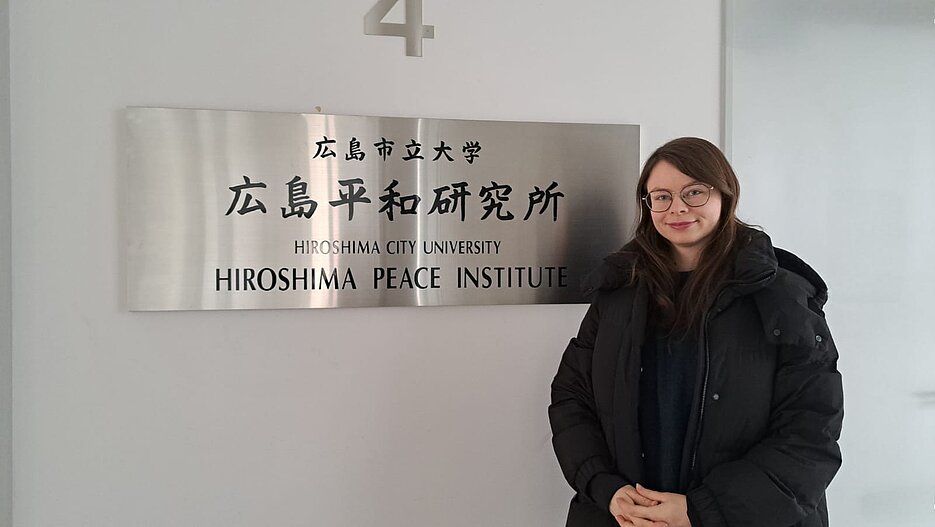Portrait mit Alumna Martyna Szoja
06.10.2025Was arbeiten Absolventinnen und Absolventen der Julius-Maximilians-Universität Würzburg (JMU)? Um den Studierenden verschiedene Perspektiven vorzustellen, befragen Michaela Thiel und ihr Team vom zentralen Alumni-Netzwerk „Uni Würzburg Community“ regelmäßig ausgewählte Ehemalige.
Nicht gerade um die Ecke... Martyna Szoja hat erst ihren Master in Chinese Studies in Würzburg gemacht und war dann in Japan. Dort hat sie am Hiroshima Peace Institut geforscht. Sie erzählt uns etwas von ihren Erfahrungen.
1. What has been the most surprising cultural difference you’ve encountered since arriving in Japan (and how have you adapted to it in your daily life)?
There are many cultural differences between Europe and Japan, but one that really stood out for me – and took some time to get used to – was the "shoes culture."
In my dormitory, Momiji (meaning maple leaf), there are very strict rules about footwear. Everyone, including guests, must leave their shoes on a special shelf at the entrance – almost like in a school. I was first given guest slippers and then bought my own pair in Hiroshima. These slippers must be worn in all common areas like the kitchen and lounge. But it doesn’t stop there. To enter the washroom, you switch into a separate pair of toilet slippers, which are usually waiting right at the entrance.
The architecture gives hints to follow this habit – spaces where shoes must be changed are slightly elevated or lowered, about 5 cm, showing a boundary.
In total, I use four pairs of shoes:
-
Outdoor shoes
-
Slippers for common areas
-
Toilet shoes
-
Slippers for the sento (hot spring bath)
Speaking of sento, many of my dorm mates (almost 100 girls) preferred evening baths in the hot spring than using the shower – I have never had a problem of taking a shower.
Even outside the dorm, shoes etiquette is serious. For example, when I attended a Noh performance in Fukuoka, everyone had to remove our shoes before climbing the stairs to the theatre hall. It was amusing to see elegantly dressed women in kimono walking around in socks.
Even on the Shinkansen (high-speed train), there are often special footrests where people remove their shoes. In Japan, shoes are considered inherently dirty, so their use is carefully restricted. It’s definitely a small but powerful insight into how much cleanliness and respect for space matter here. :)
2. What advice would you give to students from abroad who are considering studying or working in Japan?
The most important advice I can give is: respect local etiquette and cultural norms, especially in academic and professional environments.
Japanese people are extremely polite, modest, and diligent, and they often expect the same from others. Even small gestures, like bowing when greeting someone or thanking them, go a long way. That habit has stuck with me even outside Japan! And I advise to prepare yourself for the different rubbish sorting and the fact that there are almost zero rubbish bins in the public spaces.
Also, learning a few basic phrases or having a good translation app helps a lot. I personally recommend UD Talk – it offers real-time translation and is much more effective for me than relying on basic English. It really helped in university settings and even day-to-day interactions.
3. Can you share a memorable experience from your time in Japan that has made a lasting impact on you?
I have many beautiful memories from Japan, but as a theatre critic, I’ll share one from this field.
In Fukuoka, I attended a Kabuki performance at the Hakataza Theatre. The play was “The Demon Dwelling in Oboro Forest” (Oboro-yama no Oni), written by Kazuki Nakashima and directed by Hidenori Inoue. It was a stunning mix of traditional and modern styles. The climax was unforgettable, when the protagonist Rai (played by Somegoro Ichikawa) transformed into a demon and literally flew over the audience, making wild, exaggerated faces.
That moment captured everything Kabuki is about – theatricality, costume, movement, and intensity. (Fun fact: “Kabuki” comes from words meaning “strange/funny face” and “strange costume.”)
I’ve never seen anything quite like it. It was a powerful reminder of how alive traditional Japanese theatre can be, and it deepened my appreciation not just for performance art, but for Japanese culture as a whole.
Mittlerweile ist sie wieder zurück in Deutschland und macht in Duisburg ihren PhD.



